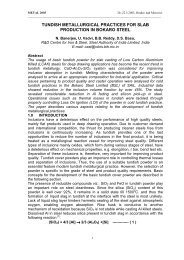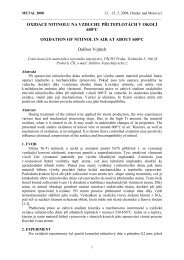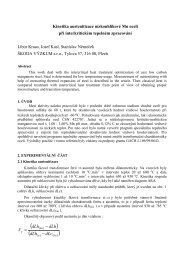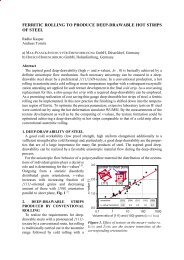CASE STUDY Nicole KYNCL - metal 2013
CASE STUDY Nicole KYNCL - metal 2013
CASE STUDY Nicole KYNCL - metal 2013
You also want an ePaper? Increase the reach of your titles
YUMPU automatically turns print PDFs into web optimized ePapers that Google loves.
15. - 17. 5. <strong>2013</strong>, Brno, Czech Republic, EU<br />
IDENTIFICATION OF BOTTLENECKS IN IRONFOUNDRY PRODUCTION – <strong>CASE</strong> <strong>STUDY</strong><br />
<strong>Nicole</strong> <strong>KYNCL</strong><br />
Komerční slévárna šedé a tvárné litiny Turnov a.s., Přepeře 326, CZ 512 61, kyncln@slevarna-turnov.cz<br />
Abstract<br />
The Theory of Constraints (TOC) presupposes that every enterprise has one constraint (bottleneck) limiting<br />
its profit, at least. In order to attain a higher profit by earning more money and to reach a higher degree of<br />
efficiency, such an enterprise has to find its constraint and take necessary measures, how to put it in best<br />
use.<br />
Article introduces possible ways to identifying constraints (bottlenecks) in the manufacturing process. It<br />
focuses primarily on identifying bottleneck by capacity calculations utilization of production resources. A case<br />
study is solved in Komercni slevarna sede a tvarne litiny Turnov a.s. during February <strong>2013</strong>.<br />
Identification of bottleneck is the first step in the application of principles and methods of TOC. If plant marks<br />
real constraint incorrectly, taken measures and improvements will not bring the expected result. For enhance<br />
the output of the plant is not necessary to have utilized all production resources at 100%. The idea is not to<br />
waste any of constrained resource.<br />
Key words: TOC, bottleneck, constraint, throughput, source<br />
1. INTRODUCTION<br />
The Theory of Constraints (TOC) was introduce in 1984 in The Goal, written by Eliahu M. Goldratt and Jeff<br />
Cox. Now, this phylosophy belongs to successfully booming methods, which offering new approach to<br />
manage and permanent improving all processes in organizations. The Theory of Constraints presents<br />
unconventional way how to solve problems and way of thinking, which is based on common sense.<br />
The core idea in TOC is that every system such as a profit-making enterprise must have at least one<br />
constraint. If it were not true, then the system would produce an infinite amount of whatever it strives for. In<br />
the case of a profit-making enterprise, it would be infinite profits. Constraint limits the system from getting<br />
more whatever it strives for. [1]<br />
Most businesses cases can be viewed as a linked sequence of processes that transform inputs into saleable<br />
outputs. In TOC, an analogy often is drawn between such a system and a chain. The chain is as strong as<br />
strong is the weakest link. If someone wants to improve the strength of a chain, he must identify the weakest<br />
link and then concentrate efforts on strengthening this single link. The weakest link (bottleneck) sets the<br />
pace for entire system. [2]<br />
Following article contains case study in Komercni slevarna sede a tvarne litiny Turnov a.s. (in futher text<br />
Komercni slevarna). This iron foundry is a traditional producer of glass moulds, grey-cast iron and ductilecast<br />
iron castings. Over 120 employees produce almost 2000 tons per year.<br />
As many other iron foundries has Komercni slevarna sede a tvarne litiny Turnov a.s. problems with keeping<br />
of confirmed terms, lot of defects during producing process, frequent changes in a production plan, and<br />
management have to solve operating problems and they do not have time for strategic decisions.<br />
The purpose of this article is to show ways how to find bottleneck in iron foundry production as a first step to<br />
improving production process by focusing on the constraints. Subsequent application TOC principles and<br />
rules stabilizate operations in iron foudry and simultaneously increase throughput, decrease work-in-process
15. - 17. 5. <strong>2013</strong>, Brno, Czech Republic, EU<br />
inventory and decrease operating expenses. Production managers are suddenly able to make a good plan,<br />
which is realistic, productive and immune against collapse.<br />
2. THEORETICAL BASIS<br />
The constraints will determine the output of the system whether they are acknowledged and managed or not.<br />
Either we manage constraints or they manage us. [4]<br />
2.1 Managing constraints – the process of ongoing improvement<br />
Ironfoundries and industrial enterprises at all have their primary constraints in production. Constraint is<br />
usually a recourse with least capacity – it could be for example a machine, workplace or worker. Constraint<br />
significant affects material flow and utilization of resource’s capacity. If production managers effectively<br />
implement ideas from TOC, constraints usually shift outside of the factory. Suddenly is a constraint demand<br />
or unreliable supplier.<br />
The Theory of Constraints presents instructions for the management of a constraint in the form of five basic<br />
steps:<br />
1. Identify the system’s constraint (bottlenecks)<br />
2. Decide, how to exploit the system’s constraint(s)<br />
3. Anything else must be subordinated to this decision<br />
4. Elimination of the constriction (if steps 2 and 3 do not help to remove the bottleneck, increase the<br />
output of the bottleneck by means of more decisive measures)<br />
5. After elimination of the bottleneck, repeat the cycle by returning to the step No. 1<br />
2.2 Identification of bottleneck<br />
The term bottleneck is taken from the 'assets are water' metaphor. As water is poured out of a bottle, the rate<br />
of outflow is limited by the width of the conduit of exit—that is, bottleneck. By increasing the width of the<br />
bottleneck one can increase the rate at which the water flows out of the neck at different frequencies.<br />
A constraint in a system is anything that limits the system from achieving its objective. Any real system must<br />
have at least one constraint that prevents it from making more profits. If a system did not have a constraint,<br />
its output would be unlimited.<br />
Ironfoundries and industrial enterprises at all have their primary constraints in production. The source with<br />
the least capacity ordinarily will be the bottleneck. The identification of a bottleneck limiting the production<br />
process as a whole can be carried out in three possible ways:<br />
by keeping under observation and on the base of one´s own experience – looking for the place of<br />
inventories accumulation<br />
capacity calculations – determination of capacity requirements for the given assortment and<br />
comparison with the capacity being available<br />
simulation<br />
3. <strong>CASE</strong> <strong>STUDY</strong><br />
In a well-run factory, the constraint can be identified easily by the location of work-in-process inventories. If<br />
the factory is well managed, they will be concentrated in front of the constraint. In a poorly run factory, workin-process<br />
inventories will be scattered all over, and identification of the real constraint is initially more
15. - 17. 5. <strong>2013</strong>, Brno, Czech Republic, EU<br />
difficult. Some managers are unable to figure out where the bottleneck is because of the chaos that has<br />
resulted from applying conventional shop control techniques over the years.<br />
3.1 Foundry introduction<br />
Komercni slevarna after privatisation in 1997 has been focused on production of commercial castings<br />
deliveries (from one piece to small or middle series) with maximal orientation on the customer, his terms and<br />
quality requirements.<br />
Raw material is melted in induction furnaces (1x 1000 kg, 2x 500 kg, 1x 9000 kg foreheart) and gravity<br />
casted in sand forms. The most of cores are manufactured in two automatic shooting machines by COLD-<br />
BOX technology. Production equipment consist of forming unit FORMTEC Air Impec, mechanical moulding<br />
FOROMAT 20, 40 (2+2) and manual moulding. Final operations by grit blasts, grinders and annealing furnace.<br />
Diverse production – various materials, dimensions, weights and quantity complicate scheduling and<br />
managing of production process. In this case is impossible to identify constraint by observation. We have to<br />
use capacity method to identify the bottleneck.<br />
3.2 Calculation of available capacities<br />
Twenty two production operations are defined in the foundry, i.e. of production sources. The production<br />
operation are registered in production process of the casting in question together with the date giving the<br />
planned requirement rate for the treatment with regard to 1 piece (see Fig. 1)<br />
Figure 1 Example of production process<br />
The information and scheduling system OPTI used in Komercni slevarna plans „from behind“. A required<br />
delivery term (according to the customer´s wish) is put into the system; the system will then calculate the<br />
source capacities step by step, starting from the last production operation and taking into account the<br />
possible time reserve. As soon as it hits the overrun available capacity of a certain source, it will shift the<br />
delivery term by 1 day and start to calculate again. And it goes in such a way as long as it plans all<br />
production operations of the production procedure. Thus the production of all individual orders is planned in
15. - 17. 5. <strong>2013</strong>, Brno, Czech Republic, EU<br />
such a way so that the production operations follow immediately one after the other and with respect to the<br />
production technology.<br />
Tab. 1 Survey of exploitation of available capacities in calendar week 8 / <strong>2013</strong><br />
Production Source Plann.<br />
unit<br />
Shift<br />
model<br />
Work./<br />
Mach.<br />
Output /<br />
hour<br />
Utiliz. Prod.<br />
degree<br />
Avail.<br />
capacity<br />
Exploitation<br />
Hand made core min 3 4 60 80 1 20880 83<br />
Cold Box 1 min 3 1 60 80 3 15660 100<br />
Cold Box 2 min 3 1 60 80 3 15660 81<br />
Shooting AVS-16 min 3 1 60 20 1 1305 0<br />
Shooting V-10 min 1 1 60 60 1 1305 68<br />
Hand moulding min 1 4 60 90 1 7830 88<br />
Moulding F20 min 1 1 60 70 1 1522 57<br />
Moulding FA min 3 1 60 90 0.65 3817 100<br />
Moulding F40 min 1 2 60 95 1 4132 83<br />
Casting kg 2 2 500 100 1 72500 100<br />
Handed discharge kg 1 1 200 100 1 7250 88<br />
Machine discharge kg 3 1 750 100 1 81563 89<br />
Grit blasting min 3 1 60 80 1 5220 100<br />
Inlet removing min 3 5 60 100 1 32625 76<br />
Grounding min 3 4 60 100 1 26100 90<br />
Finish grounding min 2 6 60 100 1 26100 100<br />
Coat kg 1 1 600 100 1 21750 62<br />
Spray coat kg 1 1 600 100 1 21750 0<br />
Annealing kg 1 1 600 100 1 21750 14<br />
Income on stock kg 1 4 600 100 1 87000 34<br />
Cooperation CZK 1 1 20000 100 1 725000 46<br />
Income workpiece kg 1 4 600 100 1 87000 15<br />
In order to calculate the available capacity of the individual sources, it was necessary to define the following<br />
data:<br />
Planned unit - each of the sources operates with a given unit of the work to be done – it can be<br />
weight (kg), time (min), and price (CZK)<br />
%
15. - 17. 5. <strong>2013</strong>, Brno, Czech Republic, EU<br />
Week model of shifts - it may have values 1, 2 or 3, depending on the one-shift, two-shift or threeshift<br />
operation in the given source<br />
Number of workers / machines - working in the given source<br />
Output in one hour - gives the maximum value per 1 hour of work (its value depends on the unit<br />
being used)<br />
Utilization of the working time - the value in % of the real work output of the source – if it is<br />
necessary to take into consideration idle time, defects, intervals for hygiene, maintenance, etc.<br />
Productivity degree - further limiting factor for individual setting up the source capacity<br />
The available capacity equals the factor of all values multiplied by working days per week (5) and the length<br />
of the working time without legislative interruptions (7.25) – vide Table 1.<br />
3.3 Exploitation of the production sources<br />
By comparison of the capacity demands of the contemporaneous assortment and the calculated available<br />
capacity, the following production sources result as the critical ones:<br />
core shooting Cold Box 1<br />
automatic moulding line (moulding FA)<br />
casting<br />
finish grounding<br />
grit blasting<br />
At first sight, it seemingly could look like the different structure of the assortment to be produced in the<br />
foundry according to customer´s orders causes the existence of floating bottlenecks. However, all indicates<br />
that the bottleneck in the Komercni slevarna is the Automatic moulding line. 88% of the produced assortment<br />
influencing directly all the critical sources pass through this line - the casting with complicated shape need a<br />
high number of cores and also a long time for finish grounding, heavy and large pieces need a lot of meltdown<br />
<strong>metal</strong> and do not exploit the full capacity of the pendant blast barrel. This is just this workplace which is<br />
critical for the efficiency of the entire foundry.<br />
4. CONCLUSION<br />
Five critical sources were ascertained by means of capacity calculations. By observing the production<br />
process and according to the accumulation of the work-in-process inventory, it is possible to certify just this<br />
conclusion. After taking the measures aiming to a higher utilization of these overloaded workplaces, it will be<br />
possible to decrease the number of critical sources and eliminate the mobility of constraints depending on<br />
the assortment to be produced.<br />
If identification of bottleneck by capacity calculations expose more than one constraint, foundries have to<br />
check these critical resources one by one to eliminate individual constraints. After accomplishment of<br />
capacity improvements on critical resources is necessary to check exploitation again. For application<br />
methods and tools of TOC to increase production process is finding right bottleneck the most important step.<br />
When the initial guess at the location of the constraint is incorrect, the system eventually let us know by the<br />
presence of unplanned work-in-process inventory accumalating in front of the real constraint.<br />
It is also necessary to realize that capacity of bottlenecks that are influenced by human work can be<br />
influenced without big problems. Quite simply, the number of workers should be accommodated in such a<br />
way that the workplace does not represent a bottleneck of the whole system. However, a problem occurs in
15. - 17. 5. <strong>2013</strong>, Brno, Czech Republic, EU<br />
the machinery workplace where there is not possible to increase the capacity in such an easy way. Possible<br />
measures aiming to the elimination of critical sources and proposals for increasing the efficiency of a<br />
bottleneck will be described in further research works.<br />
ACKNOWLEDGEMENT<br />
I would like to acknowledge the support of the logistics manager and the master of production at<br />
Komerční slévárna šedé a tvárné litiny Turnov a.s. who gave me generous acces to their annual<br />
reports. I am also grateful to my supervisor doc. Ing. Radim Lenort, Ph.D. who encouraged me to<br />
pursue this topic.<br />
REFERENCES<br />
[1] NOREEN E., SMITH D., MACKEY J. T., The Theory of Constraints and its implications for management<br />
accounting, The North River Press, 1995.<br />
[2] BASL J., MAJER P., ŠMÍRA M., Teorie omezení v podnikové praxi. Zvyšování výkonnosti podniku nástroji TOC,<br />
Grada Publishing, 2003.<br />
[3] GOLDRATT E. M., Cox J., The Goal, The North River Press, 2 Revised edition, 1992.<br />
[4] GOLDRATT E. M., Itś not Luck, The North River Press, 1994.<br />
[5] GOLDRATT E. M., Critical Chain, The North River Press, 1997.<br />
[6] LENORT R., SAMOLEJOVÁ A. Analysis and Identification of Floating Capacity Bottlenecks in Metallurgical<br />
Production. Metalurgija, January-March 2007, vol. 46, no. 1, s. 61-66.<br />
[7] LENORT R., KRAUSOVÁ E., Offer and Inquiry Management in Logistics of Metallurgical Enterprise. In Modernity<br />
of industry and services – new challenges, Vol. II. Katovice: Scientific Society for Organization and Management,<br />
2004, p. 13-20.








